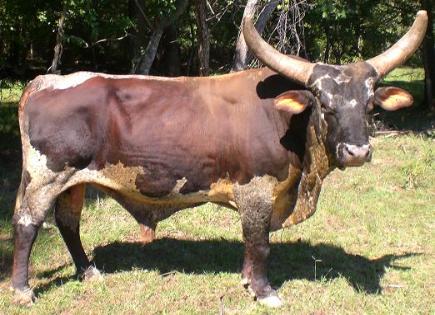April 7, 2018
Terry Lidral for Bucking Stock Talk in collaboration with Kenneth Olson, PhD, PAS, Extension Beef Specialist, Animal Science Department, South Dakota State University*
A bucking bull’s worth is greatly enhanced by his ability to become a successful breeder. There are many factors that affect breeding ability. Nutrition sits high on the list. Getting bulls ready for the breeding season through proper nutrition and conditioning can improve the rate of breeding success.
There is no one nutrition program that will meet the requirements of all bulls. Proper nutrition depends on the age, frame, body condition, desired rate of gain, activity level and environment of the bull. While bulls active in competition are most often in top condition, those off the circuit, or not yet competing, can get out of shape.
When yearling and mature bulls are run together, there can be problems with conditioning if all bulls are fed the same diet. Yearling bulls need a high energy diet to maintain the necessary rate of gain to properly develop into a breeding bull. For mature bulls put out with the yearlings, the high energy diet will most likely lead to excess gain. Yearlings tend to become under-conditioned by a lower energy diet appropriate for mature bulls.
If a bull is over-nutritioned, an external fat cover can build on the bull’s back and in his scrotum, which increases body temperature and reduces both sperm production and storage. High fat quantity can create physical stress on the bull and inhibit his ability to service cows.
An under-conditioned bull may not have the libido or physical ability to perform properly over the length of the breeding season. In yearling bulls, under-conditioning can lead to delayed puberty.
The ideal condition for a bull coming into breeding season is filled out, not overly fat. He should be toned – trim and hard, not thin. A fit bull will breed more cows and retain a higher level of libido for a longer amount of time.
Because spermatogenesis requires 60 days for completion, it is advised that the breeding bulls’ conditioning program start 60 to 90 days prior to the beginning of service.
Bulls on high grain rations should be transitioned to a forage-based diet before being turned out to pasture. This will help to prevent digestive upsets and imbalances that can be caused by sudden diet change which have the potential to create reproductive problems. There will be little opportunity for nutrition management once the bulls have been released to pasture.
Exercise is recommended for bulls to be used in the pasture breeding program. This will improve the bull’s performance and help to prevent injury from the fighting and riding that takes place in the breeding environment. Given adequate pasture space – around 2 acres per bull – bulls can be active and exercise themselves. Long, narrow paddocks, with supplemental feed supply and water sources placed far apart, encourage increased activity in the daily routine.
It is advised to provide a natural surface during the conditioning period to harden the bulls’ hooves and accustom them to walking on pasture surface. Paddocks with mud and manure footing are less than ideal as they can lead to problems associated with soft hooves or foot rot that can inhibit the bull from successful breeding activity.
Under-conditioned bulls can be put out with a limited number of cows at the start of the breeding season until body condition improves. This puts less stress on the bull and improves the chance that all cows will be serviced.
For young bulls entering their first breeding season, sexual experience can be provided by giving them a chance to breed culled or dry cows prior to being turned out. This helps build desire and libido, upping the chances that they perform their breeding duties in the cow herd.
If bulls will be turned out together in the same area for breeding, it is suggested that they be exposed to each other to develop a pecking order before the season begins. Pasture with adequate room will encourage exercise and reduce confrontation.
Bulls bothered by flies may become too distracted to service the cows. Double tagging of the ears with insecticide tags can reduce the number of problem pests.
Pasture breeding is demanding on a bull’s conditioning. It is common for a bull to lose 100 to 200 pounds during a breeding season. It is important to monitor the bulls for signs of fatigue, loss of conditioning and loss of interest. It might be wise to give yearling bulls 45 to 60 days of continuous breeding with a rotation to provide a resting period.
Once breeding season is over, it is important to provide bulls of all ages with adequate nutrition to recover the conditioning lost during the stress and demands of serving the cow herd.
- Ken Olson was raised on a ranch/dryland farm near Scobey, Montana. He received his B.S. and M.S. degrees from Montana State University and completed his Ph.D. in Range Animal Nutrition at Utah State University in 1986. After graduating, he accepted a position at the Kansas State University Agricultural Research Center–Hays where he conducted grazing livestock nutrition research. In 1992, he accepted a position on the faculty of the Department of Animal, Dairy, and Veterinary Sciences at Utah State University, where he taught undergraduate and graduate courses in ruminant nutrition and beef cattle management and continued to conduct research in grazing livestock nutrition and management. In 2006, he accepted a position as Extension Beef Specialist in the Animal Science Department at South Dakota State University. He is located at the West River Ag Center in Rapid City. His Extension programming is focused on the range-based cow-calf producers of western South Dakota.



